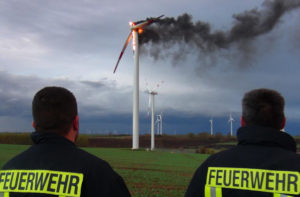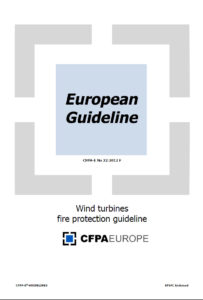2016-04-19: A Priority Theme of SFE 2016 DUBLIN, next September, is the ‘Adverse Environmental Impact’ caused by Preventable Fires in the Built Environment. Last year’s horrendous devastation of large tracts of land, air and ground waters in the Tianjin port region of North-Eastern China is one very obvious example.
BUT, consider also … Wind Turbine Fires. As we move closer and closer towards a planetary environmental precipice … there IS enormous pressure to harvest more and more energy from renewable, non-carbon resources. Windmills, of old, used wind energy to perform an important function in a local context. Everybody could see what was happening inside. Local people reaped the benefits. Modern wind turbines, on the other hand … ?
The First Major Issue concerning Wind Turbines, which received only half-hearted attention at best, was their …
Environmental Impact: Any effect caused by a given activity on the environment, including human health, safety and welfare, flora, fauna, soil, air, water, and especially representative samples of natural ecosystems, climate, landscape and historical monuments or other physical structures, or the interactions among these factors; it also includes effects on accessibility, cultural heritage or socio-economic conditions resulting from alterations to those factors.
But, at least, ‘it’ was mentioned in conversations !
.

The next major issue, the Fire Issue, is a different matter entirely. This problem does NOT exist … NEVER happens … NOBODY KNOWS NOTHING ! And not just in Ireland or Europe … the ‘real’ fire statistics are either ignored, massaged or concealed.
Wind turbines differ from other forms of traditional power generation because of the inherent risk of total fire loss of the nacelle. The main features of this risk include:
- high concentration of value within the nacelle ;
- high concentration of potential ignition sources within the nacelle, and increased risk of lightning strikes ;
- unmanned operation ;
- no possibility of fighting a fire in the nacelle by local fire service personnel, because they are too high up and/or there is no access for fire service vehicles ;
- remote, sometimes very difficult to reach geographical locations of wind turbines, particularly in the case of offshore installations.
[ Nacelle: A cover, or housing, for all of the generating components in a wind turbine, including the generator, gearbox, drive train, and brake assembly.]
The cost of wind turbines and their components, as well as restoration and repair costs after a fire, increase in proportion to installed generating capacity. In addition, losses caused by service interruption also increase in a similar proportion.
According to the loss experience of Insurers, fires in wind turbines can cause significant damage to property and have very high post-fire costs.
Fire Loss in Wind Turbines Can Occur …
- in the nacelle ;
- in the tower ;
- in the electrical sub-station of the wind turbine or wind farm.
Due to the high concentration of technical equipment and combustible material in the nacelle, fire can develop and spread rapidly. There is also the danger that the upper tower segment will be damaged. In the case of a total loss of the nacelle, restoration costs may well reach the original value of the whole turbine.
These ‘Preventable’ Fire Losses Are NOT Sustainable !
.

Which is why, in September 2012, the European Fire Protection Associations decided to publish a common guideline in order to ensure similar interpretations in the different European countries … and to give examples of acceptable solutions, concepts and models. The Confederation of Fire Protection Associations in Europe (CFPA-E) aims to facilitate and support fire protection work.
The European marketplace is constantly imposing new demands for quality and safety. According to CFPA-E, fire protection forms an integral part of a modern business strategy for survival and competitiveness. We thoroughly agree !
This CFPA-E Guideline (No.22 – September 2012) on Wind Turbine Fire Protection in Europe – produced by VdS Schadenverhütung and drafted by Hardy Rusch – is primarily intended for those people responsible for fire safety in companies and organizations. It is also addressed to fire services, consultants, safety companies, etc … so that, in the course of their work, they may be able to assist companies and organizations in increasing levels of fire safety.
.
.
END
